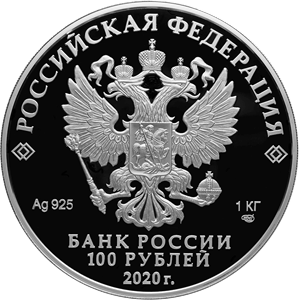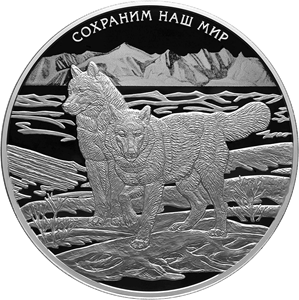Tundra Wolf
Obverse
the mirror field of the disc bears a relief image of the National Coat of Arms of the Russian Federation, over it along the rim there is the semicircular inscription ‘РОССИЙСКАЯ ФЕДЕРАЦИЯ’ (RUSSIAN FEDERATION) framed on both sides by doubled rhombuses, below under the coat of arms there are indications of the precious metal and its fineness on the left and the fine metal content and the mint trade mark on the right, at the bottom in the centre, in three lines, there is an inscription ‘БАНК РОССИИ’ (BANK OF RUSSIA), the denomination of the coin ‘100 РУБЛЕЙ’ (100 RUBLES), and the year of issue ‘2020 г.’ (2020).
Reverse
the mirror field of the disc bears a relief image of a tundra wolf and a she-wolf against a backdrop of rocks; there is an inscription ‘СОХРАНИМ НАШ МИР’ (PROTECT OUR WORLD) above along the rim.
Authors
Designers: E.V. Kramskaya (obverse), F.S. Andronov (reverse).
Sculptors: A.A. Dolgopolova (obverse), F.S. Andronov (reverse).
Mint: Saint Petersburg Mint (СПМД).
Edge: 360 corrugations.
Discover more
The polar wolf (in Latin ‘Canis lupus tundrarum’) is one of the largest subspecies of the wolf. It lives in the Arctic and tundra. The polar wolf is well adapted to life in conditions of low temperatures, strong winds, permafrost and long periods without sunlight. Since these territories are unsuitable for human life, it is not threatened with extermination.
The polar wolf has a light, almost white in winter, coat colour, thick fur, pointed ears, long legs, and large paws. Life expectancy in the natural environment is 5-6 years.
Wolves are pack animals. The base of the pack is the leader and female leader with the other members being their last and penultimate offspring. Sometimes the pack includes older family members and other related individuals who have not found a partner. Within the pack, the social hierarchy is strictly observed: what is permissible for wolves who occupy a high position in the pack is absolutely unacceptable for other members. Standing at a lower hierarchical level, wolves implicitly obey the authority of the leaders, for example, when dividing the spoils. There are almost no bloody confrontations between members of the same pack.
Interaction within the pack occurs through a complex language consisting of body movements, barking, growling, and yelping. Howling wolves warn other packs of their presence in the area.
The polar wolf feeds on lemmings, polar hares, as well as larger prey, without which the pack cannot survive – reindeer and musk oxen. The latter are extremely difficult to catch because of their well-coordinated manner of defence, so although wolves are very hardy and patient and can track down prey for a long time, hunting is often unsuccessful. The pack has to go without food for several days.
The mating period for wolves runs from January to March. A pregnant she-wolf leaves the pack in search of a den to give birth to pups and takes care of them until they acquire hunting skills. All adult wolves are sensitive to cubs.
In autumn and winter, polar wolves migrate to the south following herds of musk oxen and deer. By that time, the cubs have gained enough strength and experience to become full members of the pack and migrate with adults.


